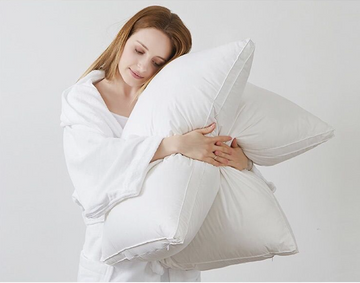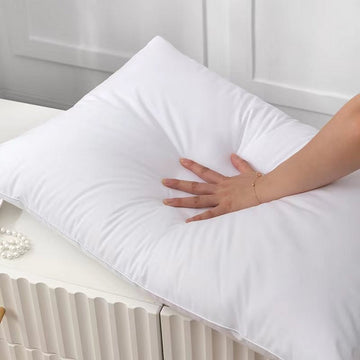Understanding Pillow Types and Materials
The Pros and Cons of Different Pillow Fillings
When seeking the ultimate pillow, consider what's inside. The filling affects comfort, support, and longevity. Here’s a simple guide to pillow fillings:

- Down and Feather: Soft and long-lasting, down pillows offer luxury. But they can be pricey and not suit allergy sufferers.
- Memory Foam: Adapts to your shape for customized support. However, they can retain heat and might have a strong initial odor.
- Polyester: A budget-friendly option that's easy to care for. Yet, it tends to flatten over time and may not offer enough support for some.
- Buckwheat: They offer excellent support and air circulation. But, they are heavy and might be too firm for some people.
- Latex: Resistant to dust mites and mold, latex pillows are hypoallergenic. They can be firm, though, and may not appeal to those who prefer a softer pillow.
Choose based on your comfort preference, budget, and any allergies or health issues.
Natural vs Synthetic: Which Should You Choose?
Choosing between natural and synthetic pillows can be tough. We want our bed to be a cozy spot. Both types have good and not-so-good points. Natural pillows often feature feathers, down, or wool. They are soft and long-lasting. But, they might trigger allergies in some people. On the other hand, synthetic pillows use materials like polyester. They are lighter on the wallet and often anti-allergy. Yet, they may not last as long. Think about comfort, how long you want the pillow to last, and allergies when deciding. Your choice will shape the comfort of your sleep for a long time.
Specialty Pillows: Memory Foam, Latex, and More
Specialty pillows, like memory foam and latex, offer unique benefits for sleep comfort. Memory foam contours to your body, helping with pressure points. It’s good for most sleep positions. Latex pillows are firm and bouncy, supporting your neck well. They tend to keep cool and are durable. Other specialty types include cooling gel pillows to regulate temperature and water-filled pillows for adjustable firmness. When picking a specialty pillow, consider if it suits your sleep style and any health needs.
How to Choose the Right Pillow for Your Sleep Position
The Best Pillows for Side Sleepers
Side sleepers need a pillow that supports the neck and shoulder gap. A thicker pillow with medium firmness works best. Memory foam or a firm down pillow can provide the right contour. Look for a pillow that keeps your spine straight. This reduces stress on your body. A contoured pillow can also help. It fits the shape of your neck. For side sleepers with allergies, hypoallergenic options are good. A pillow with adjustable fill is useful too. You can change the height as needed. This guide can help you find a comfortable pillow for side sleeping.
Recommended Pillows for Back Sleepers
Choosing a pillow for back sleepers is key for comfort and support. Here are some tips:
- Pick a medium-firm option that keeps your head and neck aligned.
- Memory foam pillows mold to your shape, offering stable support.
- Contoured pillows can also help maintain natural spine curvature.
- Avoid overly fluffy pillows that might cause your head to sink too low.
- A cooling pillow can prevent overheating for a restful sleep.
Remember, the right pillow can aid in preventing back pain.
Optimal Pillow Choices for Stomach Sleepers
Stomach sleepers need specific pillow features for comfort and support. A thin, flat pillow is best to keep the spine aligned. Soft fillings like down or low-density foam prevent neck strain. Avoid firm or high pillows that tilt the head upwards, straining the neck. Look for a pillow that cradles the head while maintaining a natural position. In summary, stomach sleepers should choose a soft, flat pillow for the best rest.
Care and Maintenance of Your Pillow
Tips for Cleaning and Prolonging Pillow Life
- Start by reading the care tag for specific instructions.
- Use pillow protectors to shield from dirt and oils.
- Wash pillows as directed, typically two to three times a year.
- Dry properly to prevent mold; some can go in a dryer on low heat.
- Fluff daily to maintain shape and comfort.
- Air out pillows occasionally to keep them fresh.
- Spot clean spills or stains immediately to avoid set-in marks.
- Store in a cool, dry place if not in use for long periods.
When to Replace Your Pillow
Knowing when to replace your pillow is key for good sleep health. Here are signs it's time:
- Flattened Shape: If it doesn't bounce back when folded in half.
- Lumps and Unevenness: When the filling clumps and comfort is lost.
- Stains and Odors: Persistent smells or stains suggest buildup of sweat and oils.
- Increased Allergies: If waking up with a stuffy nose, your pillow may be to blame.
- Age: Most pillows last 1-2 years. Memory foam may last up to 3 years.
Replace old pillows for better sleep and health. It helps maintain hygiene and prevents neck pain from poor support.
Allergen Considerations and Hypoallergenic Options
Pillows can gather allergens over time. Dust mites and mold can cause allergies. Hypoallergenic pillows help avoid this. They are made from materials that fight allergens. Look for pillows with natural hypoallergenic fills. Bamboo, silk, or wool are good options. Synthetic options like memory foam also resist allergens. Always check pillow labels for 'hypoallergenic' claims. Replace pillows regularly to keep allergen build-up low. Using pillow protectors can also help. Wash them often to keep your sleep space clean and safe.






